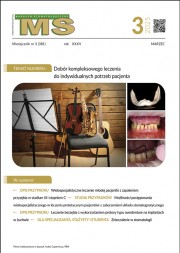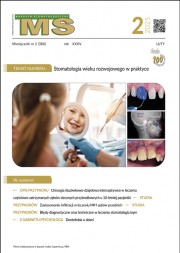Dostęp do tego artykułu jest płatny.
Zapraszamy do zakupu!
Po dokonaniu zakupu artykuł w postaci pliku PDF prześlemy bezpośrednio pod twój adres e-mail.
STUDIA PRZYPADKÓW
Granulicatella adiacens i Rothia mucilaginosa jako rzadkie patogeny wywołujące stany zapalne w regionie szczękowo-twarzowym – prezentacja dwóch przypadków
Granulicatella adiacens and rothia mucilaginosa – rare pathogens triggering infections in the maxillofacial region – presentation of two cases
Karolina Grzegorczyk, Marta Tyndorf, Artur Wróbel-Roztropiński, Lidia Kruczykowska, Dawid Zagacki, Marcin Kozakiewicz
Streszczenie
Wstęp: Procesy zapalne wywoływane przez Granulicatella adiacens oraz Rothia mucilaginosa najczęściej występują wśród pacjentów z immunosupresją i są przyczyną infekcji oportunistycznych. Przypadki ropni w regionie głowy i szyi związanych z tymi mikrobami należą do rzadkości. W pracy przedstawiono dwa przypadki, które były leczone w Klinice Chirurgii Szczękowo-Twarzowej Uniwersytetu Medycznego w Łodzi.
Metodyka badań: Została przeprowadzona retrospektywna analiza dokumentacji medycznej. Do badań włączono dwóch pacjentów.
Wyniki: Dwóch pacjentów z masywnym ropniem zostało włączonych do niniejszej pracy. U pacjentów przeprowadzono drenaż treści ropnej oraz pobrano materiał do badania bakteriologicznego, które wykazało w pierwszym przypadku nadkażenie Granulicatella adiacens, a w drugim przypadku Rothia mucilaginosa. Obaj pacjenci byli leczeni chirurgicznie oraz farmakologicznie antybiotykami o szerokim spektrum działania.
Abstract
Background: Inflammatory process caused by Granulicatella adiacens and Rothia mucilaginosa is present among patients with immunosuppression and are causative agents of opportunistic infections. Cases of abscess in the head and neck region associated with those microbes are rare. We therefore would like to present two cases that were present in our clinic and its clinical course.
Methods: A retrospective analysis of the medical documentation was performed. Two patients were incorporated into our study.
Results: Two patients with massive abscess were incorporated into the study. The drainage of the puss was performed and microbiological examination was performed revealing Granulicatella adiacens infection in the first case and Rothia mucilaginosa in the second case. Both were treated surgically and pharmacologically with a broad-spectrum antibiotics.
Hasła indeksowe: infekcje, ropień, granulicatella adiacens, rothia mucilaginosa
Key words: infections, abscess, granulicatella adiacens, rothia mucilaginosa
Piśmiennictwo
-
Peterson LJ. Chirurgia stomatologiczna i szczękowo-twarzowa. B. Pogorzelska-Stronczak (red.), A. Bubiłek-Bogacz (tłum.). Lublin: Wyd. Czelej; 2001, s. 415-417.
-
Kulkarni AS, Narayanan V. Bacteriological profile and antibiotic sensitivity patterns of odontogenic abscesses in patients with a history of empiric antibiotic therapy. AOMS. 2006; 18(4): 272-279.
-
Chiapasco M, Tommaso A, Casentini P. Chirurgia stomatologiczna, wyd. 3. M. Dominiak, T. Kaczmarzyk (red.), A. Bednarczyk i wsp. (tłum.). Wrocław: Edra Urban & Partner; 2020, s. 201-202.
-
Agarwal AK, Sethi A, Sethi D i wsp. Role of socioeconomic factors in deep neck abscess: A prospective study of 120 patients. Br J Oral Maxillofac Surg. 2007; 45(7): 553-555.
-
Michels F, Colaert J, Gheysen F i wsp. Late prosthetic joint infection due to Rothia mucilaginosa. Acta Orthop Belg. 2007; 73(2): 263-267.
-
Fusconi M, Conti C, De Virgilio A i wsp. Polmonite paucisintomatica da Rothia mucilaginosa: caso clinico e rassegna della letteratura [Paucisymptomatic pneumonia due to Rothia mucilaginosa: case report and literature review]. Infez Med. 2009; 17(2): 100-104.
-
Tomczak H, Bilska-Stokłosa J, Osmola K i wsp. Rothia mucilaginosa, rarely isolated pathogen as an etiological factor of infection of soft tissues in young, healthy woman. Postepy Hig Med Dosw (Online). 2013; 67: 1-5.
-
Paściak M, Holst O, Lindner B i wsp. Structural and serological characterization of the major glycolipid from Rothia mucilaginosa. Biochim Biophys Acta. 2004; 1675(1-3): 54-61.
-
Fatahi-Bafghi M. Characterization of the Rothia spp. and their role in human clinical infections. Infect Genet Evol. 2021; 93: 104877.
-
Kobayashi T, Uchibori S, Tsuzukibashi O i wsp. A selective medium for Rothia mucilaginosa and its distribution in oral cavities. J Microbiol Methods. 2012; 91(3): 364-365.
-
Tsuzukibashi O, Uchibori S, Kobayashi T i wsp. Isolation and identification methods of Rothia species in oral cavities. J Microbiol Methods. 2017; 134: 21-26.
-
Elfessi Z, Liu E, Dukarevich Y i wsp. Sepsis induced bacterial peritonitis caused by Granulicatella adiacens. Am J Emerg Med. 2019; 37(12): 2263.e1-2263.e3.
-
Ku CA, Forcina B, LaSala PR i wsp. Granulicatella adiacens, an unusual causative agent in chronic dacryocystitis. J Ophthalmic Inflamm Infect. 2015; 5: 12.
-
Christensen JJ, Facklam RR. Granulicatella and Abiotrophia species from human clinical specimens. J Clin Microbiol. 2001; 39(10): 3520-3523.
-
Gardenier JC, Hranjec T, Sawyer RG i wsp. Granulicatella adiacens bacteremia in an elderly trauma patient. Surg Infect (Larchmt). 2011; 12(3): 251-253.
-
Gupta S, Garg M, Misra S i wsp. Granulicatella adiacens abscess: Two rare cases and review. J Lab Physicians. 2018; 10(1): 121-123.
-
Oie S, Mochizuki K, Ishida K i wsp. Case of late-onset bleb associated endophthalmitis caused by Rothia mucilaginosa. J Infect Chemother. 2016; 22(9): 645-647.
-
Franconieri F, Join-Lambert O, Creveuil C i wsp. Rothia spp. infective endocarditis: A systematic literature review. Infect Dis Now. 2021; 51(3): 228-235.















